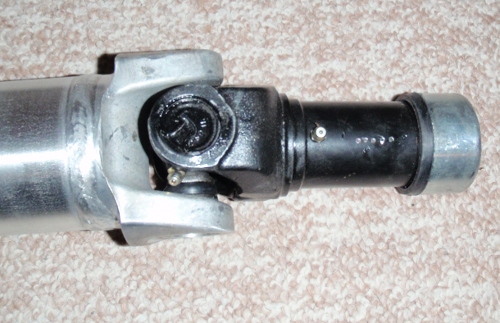PST Aluminum Driveshaft
Immediately following my installation of the Enkei GTC-01 wheels and the Dejon Tools Y-Pipe I picked up the strangest vibration. Under load, at high speeds, the car would start harshly vibrating, as if I was driving over the rumble strips on the side of an Interstate.
This vibration - which is really very violent - only happens under load, and while it only happens at high speeds (north of 100 km/h), is not specifically speed-dependant, as it vanishes on lift throttle. It also doesn't show up in the AEM logs as knock or any other odd behaviour.
Given that it started happening just after the wheel and tire upgrade, plus the aftermarket Y-Pipe (which brought with it the crappy Chinese copy of a Greddy BOV) odds are that the vibration is directly related to one of these upgrades. The wheels and tires are unlikely to be the root cause; Tire Rack did a full road-force balance on them, plus the vibration only occurs under load. One would expect a tire imbalance vibration to occur at a set road speed and independent of load or coasting.
But while inspecting the car for other possible signs of trouble, I discovered that the driveshaft carrier bearings were shot. Furthermore, the driveshaft itself looked to be in fairly rough shape. The wheel and tire upgrade changed the diameter of the wheels slightly, so the relationship between road speed and driveshaft speed had also changed; it is conceivable that this moved the driveshaft's harmonics around enough to push it into a vibration mode.
Given the known fact that the carrier bearings were toast (and thus needed repairing no matter what) I elected to replace the entire driveshaft assembly.
So which one?
I had good luck with an ACPT Carbon Fibre driveshaft on the Talon - at least as so far as it was light and didn't induce any new problems. The prices on carbon shafts have fallen considerably since the late 90s and can be had for ~$1500. Notwithstanding the drop in price though, $1500 still isn't "cheap" by any means.
OEM Mitsubishi shafts are expensive and hard to come by. They also retain the 3-piece design, which means more carrier bearings to fail and joints to wear out.
So I elected to go with a PST 2-piece aluminum shaft, at $750 or so. Half the price of carbon, but still a nice weight reduction and all new bearings and joints.

This shaft is available as a one-piece shaft as well, but one piece shafts can be sensitive to the angles at the transfer case and pinion - especially when the car was designed to use a multi-piece shaft. Given that the goal here is vibration elimination, not weight reduction, there was no reason to risk the possibility of inducing even more vibration by trying to use a 1-piece shaft.
When the shaft arrived, some differences between the way ACPT and PST builds their shafts became apparent:
- Firstly, the DSM shaft uses a small steel stub shaft (at the rear) and a Lobro joint to connect the two shaft sections; the Stealth uses a much larger steel shaft (at the front) and a splined slip joint to connect the two shafts.
- The carrier bearing on the DSM shaft is pressed onto the rear stub shaft, behind the Lobro joint; on the Stealth the carrier bearing collar is pressed onto the rear shaft, and the outer race of the carrier bearing slides into the rubber of the carrier bearing mount. This had me fooled for a little while; it looked like the carrier bearing rubber was too deep and the bearing collar itself too short to be properly supported. The trick was realizing that the carrier bearing rubber stretches over the protrusion on the bearing collar so as to capture it.
- Finally, unlike the DSM shaft, the Stealth shaft has zerk fittings for greasing the u-joints (a nice plus).

After having examined how this part is designed, it is clear that the reason why the front steel shaft is steel is because the male splined section of the inter-shaft slip joint must be steel to fit into the mating female splines of the inter-shaft U-Joint - and the male splines are welded solidly to the shaft. There's no way to weld steel to aluminum, so if you use that slip joint design, the male shaft must be steel. That's a shame, as it prevents making the front shaft out of aluminum as well.
On to installation:
Happily, and unlike most other aftermarket parts, the PST driveshaft fit perfectly. No tweaking, grinding, or other shenanigans were required to get it installed. It just bolted right up.

Out of the car, the old driveshaft had some rotational play in the Lobro joint and the front U-Joint was stiff. That, plus the shot carrier bearings, mean that the old shaft had worn out and definitely needed fixing.
Out on the road, the new shaft reduced (and nearly eliminated) the clunks from under the car when lifting throttle or putting the car into gear. Unfortunately, it did not eliminate the "high speed light load virtual rumble strips" problem that prompted the installation - meaning that the old driveshaft, as worn as it was, was not the root cause of the problem. The quest to figure out just what the hell that noise is continues.
